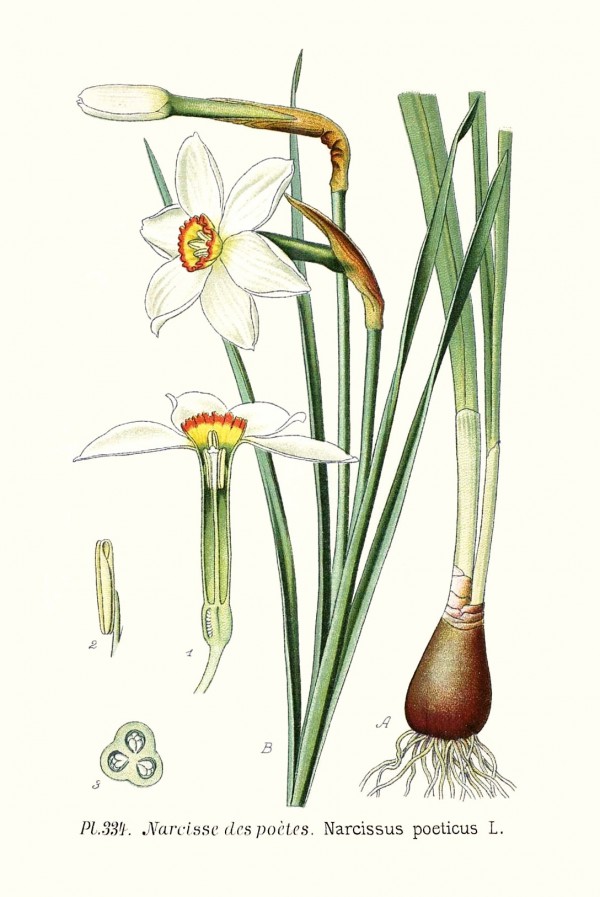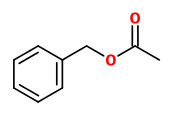Narcissus poeticus L. - Amaryllidaceae - poet's narcissus, pheasant's eye, Weiße Narzisse
Perennial herb, up to 45cm high, native to central and southern Europe, naturalized and cultivated as ornamental; leaves four, flat, up to 40cm long, green to glaucous; inflorescense 1-flowered; perianth white, 5-7cm wide, tube 2-3cm, petals ovate 1.5-2cm long; corona yellow with red, crenulate margin, cup-shaped.
http://www.efloras.org/florataxon.aspx?flora_id=1&taxon_id=220008994
„Poet's daffodil is cultivated in the Netherlands and southern France for its essential oil, narcissus oil, one of the most popular fragrances used in perfumes.“ https://en.wikipedia.org/wiki/Narcissus_poeticus
A vacuum headspace concentrate of the flowers contained mainly benzyl alcohol (21%) and α-terpineol (19%). Minor components were lilac alcohols (three isomers), lilac aldehyde (one isomer), dihydroactiniolide, and benzothiazolone.
[Joulain, D. „Study of the fragrance given off by certain springtime flowers.“ Progress in essential oil research (1986): 57-67]
„Another scent highly regarded for its intensity and complexity emerges from the absolute of narcissus (Narcissus poeticus). Initially, it exhibits a strong green, woody and earthy note, and only upon dilution additional sweet floral, heavy and balsamic notes are discovered.“
Main components of the odoriferous part of the absolute (20%) are α-terpineol (23.7%), methyl isoeugenol (20.0%), benzyl benzoate (19.4%), coumarin (6.9%), benzyl alcohol (5.0%), Δ3-carene (3.4%), phenylethanol (2.2%), ethyl palmitate (2.2%), cinnamic alcohol (2.2%), phenylpropyl acetate (1.7%), 1,8-cineole (1.5%), caryophyllene (1.0%), and benzyl acetate (0.7%). Minor components are: β-ionone, epoxy-β-ionone, (E,Z)-2,6-nonadienal, and (E)-2-nonenal contributing a violet note; various phenols adding orange flower and ylang-ylang shades; methyl-β-orcinol carboxylate (evernyl), methyl everninate, and orcinol dimethyl ether adding woody notes; phenylacetonitrile, jasmine lactone and 1-p-menthen-9-al introducing floral shades.
[Müller, P. M., and D. Lamparsky. „Perfumes: art, science and technology.“ 1994, 515-517]
„In case of narcissus, fragrance is extracted via hexane or petroleum ether solvent from flowers resulting in 0.2-0.3% concrete or by supercritical CO2 extraction resulting in a yield of 0.41% (Ehret et al., 1992; Ferri et al., 2009). In case of solvent extraction, it takes 1000 kg of flowers to produce 2kg of concrete or 750 g of absolute and the relative low productivity of absolute from narcissus makes it an expensive product, restricted to luxury perfumes.“
Headspace solid-phase microextraction (HS-SPME) and GC-MS were applied to analyze flower scent. Simple and double flower cultivars showed circadian emission patterns and produced significantly less scent during the night than during the day. Main floral scent constituents were e.g.:
Simple flowers: benzyl acetate (37.3%), (Z)-β-ocimene (34.8%), indole (4.6%)
Double flowers: (Z)-β-ocimene (21.8%), benzyl acetate (19.3%), 1,8-cineole (8.8%), phenylethyl acetate (8.4%), hydroxycinnamyl acetate (6.6%), tert-butyl benzene (6.1%), linalool (5.9%), indole (2.7%), 3-methyl-2-buten-1-yl acetate (2.0%)
[Optimization of fragrance extraction: daytime and flower age affect scent emission in simple and double narcissi., Ruíz-Ramón, F., Águila, D. J., Egea-Cortines, M., Weiss, J., Industrial Crops and Products, 52, 2014, 671-678]
Main components of SFE-CO 2 extracts of N. poeticus freeze-dried flowers were alkans (41-54%) like heptacosane (11-15%), tricosane (7-11), nonacosane (5-7%), untriacontane (4-6%), pentacosane (4-6%) and heneicosane (3-5%), followed by aromatics like benzyl benzoate (9-10%), benzyl linoleate (1-2%), benzyl alcohol (0.1-1.0%), benzyl linolenate (0.2-0.5%) and phenylethyl benzoate (0.05-0.18%). Olfactorly interesting volatiles are e.g. cis-3-hexenol (0.1-0.8%), heptanal, limonene, benzyl alcohol (0.1-1.0%), p-cresol (tr-0.1%), nonanal (0.3-0.4%), octanoic acid (tr-0.07%), α-terpineol (1.0-3.4%), hydrocinnamyl alcohol (tr-0.09%), carvone (tr-0.08%), nonanoic aicd (0.2%), (2E,4Z)-decadienal (0.1-0.4%), (2E,4E)-decadienal (0.2-0.6%), β-ionone epoxide (0.2-0.4%), dihydroactinidiolide (0.4-0.6%), γ-dodecalactone (0.09-0.14%), and traces of vanillin, isoeugenol, methyl isoeugenol, β-ionone, and γ-undecalactone.
[Baranauskienė, Renata, and Petras Rimantas Venskutonis. „Supercritical CO2 Extraction of Narcissus poeticus L. Flowers for the Isolation of Volatile Fragrance Compounds.“ Molecules 27.2 (2022): 353] https://www.mdpi.com/1420-3049/27/2/353/pdf

Narcissus poeticus L.: Masclef, A., Atlas des plantes de France, vol.3 t.334 (1893)
http://plantillustrations.org/species.php?id_species=691448

Narcissus poeticus CC BY-SA 3.0 Andreas Kraska
Narcissus poëticus × N. pseudonarcissus © Rolf Marschner (2009) botanische-spaziergaenge.at





